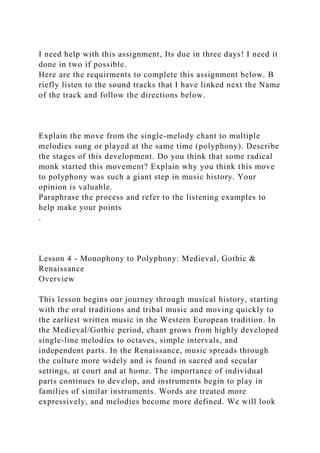
I need help with this assignment, Its due in three days! I need it d.docx
- 1. I need help with this assignment, Its due in three days! I need it done in two if possible. Here are the requirments to complete this assignment below. B riefly listen to the sound tracks that I have linked next the Name of the track and follow the directions below. Explain the move from the single-melody chant to multiple melodies sung or played at the same time (polyphony). Describe the stages of this development. Do you think that some radical monk started this movement? Explain why you think this move to polyphony was such a giant step in music history. Your opinion is valuable. Paraphrase the process and refer to the listening examples to help make your points . Lesson 4 - Monophony to Polyphony: Medieval, Gothic & Renaissance Overview This lesson begins our journey through musical history, starting with the oral traditions and tribal music and moving quickly to the earliest written music in the Western European tradition. In the Medieval/Gothic period, chant grows from highly developed single-line melodies to octaves, simple intervals, and independent parts. In the Renaissance, music spreads through the culture more widely and is found in sacred and secular settings, at court and at home. The importance of individual parts continues to develop, and instruments begin to play in families of similar instruments. Words are treated more expressively, and melodies become more defined. We will look
- 2. into the favorite styles of the time--motets for sacred music, and madrigals for secular music. What You Will Learn After successfully completing this lesson, you will understand · the great leap that took place with written notation. · the melodic complexity and influence of the Gregorian chant. · the breakthrough in the move from monophony to polyphony (and the features of each). · the features of organum, motets, and madrigals. · the major musical terms associated with the period. · the contributions of the era's prominent composers. Listening Assignment Alleluia: Vidimus stellam - https://www.youtube.com/watch?v=ApX4DJvPpEg O successores by Hildegard of Bingen - https://www.youtube.com/watch?v=8mRpGUu2mXk Alleluia Dies Sanctificatus by Léonin - https://www.youtube.com/watch?v=wBs-qf8AUCc Agnus Dei, Notre Dame Mass - https://www.youtube.com/watch?v=AKpexxzR4Ak Ave Maria by Josquin Desprez - https://www.youtube.com/watch?v=UStX-kdE-tM As Vesta Was Descending - https://www.youtube.com/watch?v=XGTB1q2yEhQ Song of the Birds ( Chant des oiseaux ) - https://www.youtube.com/watch?v=x-dkdgzYZbQ
- 3. Study Activities Complete the Study Activities for this lesson found in the student guide. Summary In a remarkably short time, there was a growth in the Medieval/Gothic period from monophony to polyphony, with highly developed single-line chants giving rise to additional parts that gained increasing freedom. The move from monophony to polyphony went through several distinct stages of organum. Each stage contributed to the new freedom of independent parts. The earlier chants remained the basis for these new compositions through a technique called cantus firmus . The result of this progression was four independent parts with different but complementary melodic activity. In the Renaissance, polyphony continued to develop, with imitation as a favored practice. Instruments began to play in families (consorts). The favorite form of sacred music was choral works called motets. In secular music, the counterpart was the madrigal, and the move was from courtly to popular forms, a more expressive treatment of words, and more clearly defined melodies. Pope Gregory